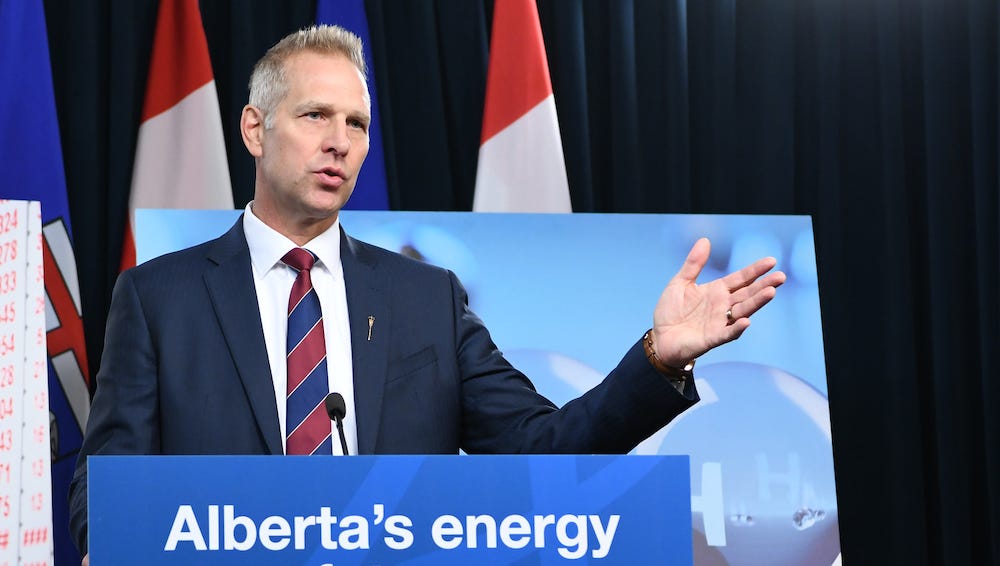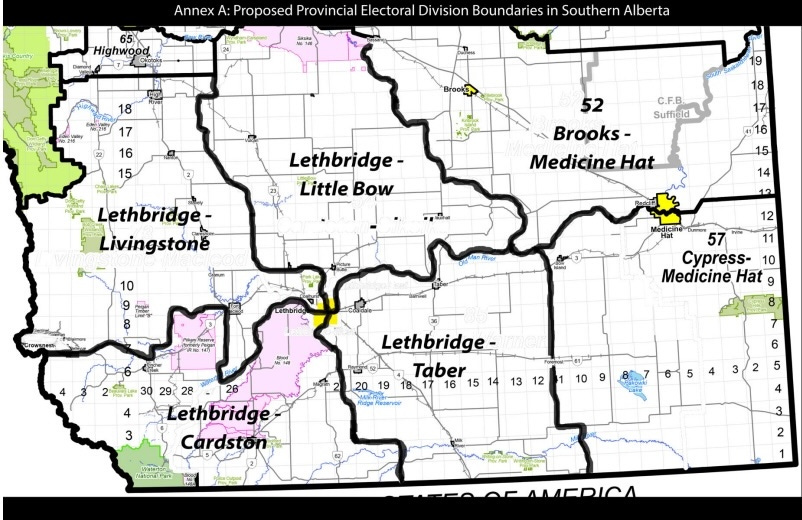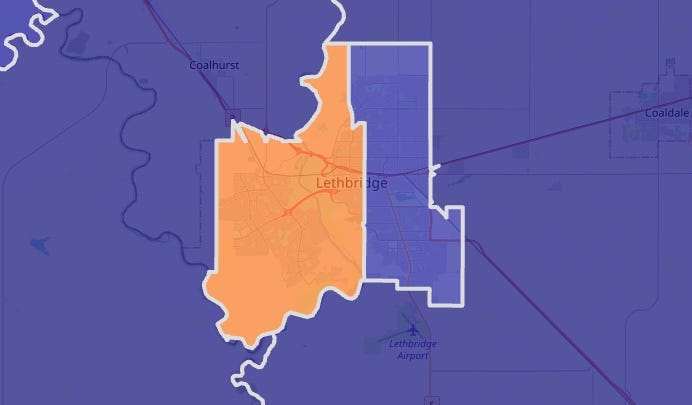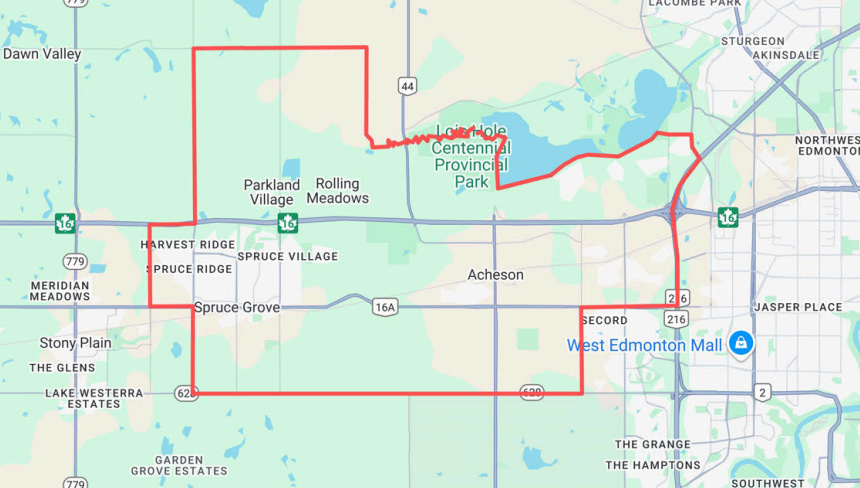UCP MLA Nathan Neudorf wants Lethbridge carved into 3-4 big rural-urban ridings
I read all 197 submissions to Alberta’s Electoral Boundaries Commission so you don’t have to

The City of Lethbridge could be carved into four provincial ridings that sprawl into the surrounding rural areas if a local United Conservative Party MLA gets his wish. Lethbridge-East MLA Nathan Neudorf submitted a written proposal to the Electoral Boundaries Commission calling for the southwest Alberta city to be reconfigured into “three or four complementary ridings that create a cohesive “agri-innovation corridor.”
Neudorf’s submission, which is one of 197 written submissions received by the commission and posted on its website, proposes a dramatic change in the electoral map he says would give “producers, processors, researches, and urban businesses a unified voice in the Legislature.”
“I respectfully ask the Commission to explore boundary options that draw together Lethbridge-East, Lethbridge-West, and logical portions of the adjacent rural divisions lined above into three or four ridings based on shared agricultural and economic interest,” wrote Neudorf, who also serves as Alberta’s Minister of Affordability and Utilities and Vice Chair of Treasury Board. “I am confident this would enhance effective representation for both urban and rural areas.”
The current urban ridings of Lethbridge-East and Lethbridge-West have existed since 1971 within Lethbridge city limits. The NDP have represented Lethbridge-West since 2015 and Neudorf has held Lethbridge-East for the UCP since 2019. The population of the two urban ridings remain fairly close to the average riding population the commission is aiming to achieve.
There are legitimate concerns with the shape of the current sprawling rural ridings surrounding the city, particularly the hour-glass shaped Cardston-Siksika riding, but slicing the City of Lethbridge into four large rural-urban ridings would almost certainly be seen as gerrymandering that would guarantee a UCP sweep of Lethbridge’s representation in the Legislature.
Neudorf isn’t the only prominent UCP voice calling for the creation of multiple rural-urban ridings in the Lethbridge region. City Councillor John Middleton-Hope, who ran against NDP MLA Rob Miyashiro in the December 2024 by-election in Lethbridge-West, also called for the city’s riding boundaries to be expanded to include surrounding rural areas.
“A realignment to include Coalhurst and Ft. MacLeod into LA-West to provide a blend of rural and urban,” wrote Middleton-Hope in his submission to the boundaries commission. “LA East should include South LA and east of the county and Coaldale. While a third new riding would take in North LA and the county from HWY 3 around to Coalhurst.”

Town of Coaldale Deputy Mayor Lisa Reis submitted a similar written proposal calling for Lethbridge to be carved up and included detailed maps of how she would like to see the region’s provincial ridings redrawn. Her proposal calls for the creation of new Lethbridge-Cardston, Lethbridge-Livingstone, Lethbridge-Little Bow, and Lethbridge-Taber ridings.
“Communities like Coaldale, Coalhurst, Picture Butte, Taber, and others rely on Lethbridge for key services—and in turn, they contribute to the strength of the region,” Reis wrote. “Moreover, decisions made in Lethbridge have a real and lasting impact on surrounding towns like ours. Whether it’s planning for growth or responding to challenges, we do better when we’re recognized as part of a shared region with shared needs.”
Submissions identical to Reis’ letter were also submitted by Coaldale Chamber of Commerce President Robert Woolf, and Town of Coaldale Chief Administrative Officer Kalen Hastings and Deputy CAO Cameron Mills.
But support for the idea is far from unanimous.
University of Lethbridge political science instructor and former city councillor Jeff Coffman urged the commission to view municipal boundaries as not simply demarcations of local jurisdiction but as unique policy units, each with its own political identity and values. He spoke to the commission at an in-person public hearing on May 29:
As a former councillor and as an interim CAO I know that the citizens of Lethbridge are not the citizens of Coalhurst and vice versa even though they are separated by nine kilometres. Each is different.
And when I say “different,” I’m not referring to any ideological alignment or how someone votes. By differences I mean communities of interest. Dr. James Lightbody, formerly of the University of Alberta, would identify this as, quote, the local norms and expectations, unquote, that lead municipalities towards their own approaches and policy directions to meeting local challenges, and these challenges are different for each community. When you take part of a large urban centre to create a rurban, rural-urban, district, you fail to understand or respect the fact that the residents in both the urban and rural communities have different cultures, economic and historic values, goals, and considerations. For example, the local norms and expectations for the people of Coalhurst or Picture Butte or Lethbridge county are different from the local norms and expectations for Lethbridge residents.
Coffman isn’t alone in this view.
Lethbridge resident Anastasia Sereda asked in her written submission that the commission maintain the integrity of the city’s municipal boundaries in its electoral map to recognize the unique demographic realities and diversity and complexity of that urban community. Scott Paul wrote that he saw “no rationale or compelling need for the current electoral boundaries for Lethbridge East or Lethbridge West to be adjusted” and Barb Phillips wrote that "Lethbridge is well served by the two current constituencies."

Dr. Craig Coburn, a professor in the University of Lethbridge’s Department of Geography and Environment, also wrote a submission in support of the current two urban ridings.
“As it stands, I believe the boundaries of the two electoral districts that represent the urban areas of Lethbridge should remain unchanged. I am not in support of altering the boundaries of urban electoral districts to include populations that are not part of the same community,” wrote Coburn.
"There is no question in my mind that the concerns of citizens in rural areas are not at all like my concerns as someone living in an urban area,” Coburn argued. “This is not to dimmish the concerns of rural Albertans, but to ensure that their voice if appropriately represented and not lost in the context of urban issues.”
Former Medicine Hat MLAs want big changes
East of Lethbridge, two former Medicine Hat MLAs are asking the commission to redraw the Medicine Hat ridings after the city was divided into two large rural-urban ridings when the riding boundaries were last redistributed in 2017.
Different submissions from Rob Renner, who was the Progressive Conservative MLA for Medicine Hat from 1993 to 2004, and Bob Wanner, who represented Medicine Hat as an NDP MLA from 2015 to 2019, argued that pairing the Medicine Hat with the City of Brooks in the current Brooks-Medicine Hat riding doesn’t well-serve the interests of Alberta’s sixth largest city.
Renner argued that Bow Island and Forty Mile County should be included in a new Medicine Hat-Redcliff riding and Wanner called for the creation of an urban Medicine Hat-North riding that included the city north of the Trans-Canada Highway.
Speaking in support of the current boundaries, Cypress-Medicine Hat UCP MLA Justin Wright told the commission at its June 23 virtual hearing that “Medicine Hat and its surrounding communities have become increasingly integrated across economic, educational, cultural, and service lines. The current what I call rurban, which is a combination of rural and urban, is not only functional but foundational on how to best represent and deliver the expectations of this region.”
“Blended ridings serve our communities well because our communities themselves are blended in practice. Medicine Hat must continue, in my opinion, to be represented by two blended MLAs who together reflect the full character of diversity and ambition of southeastern Alberta.” Wright said.
Former Calgary mayor asks commission to respect Calgary’s municipal boundaries
Former Calgary mayor Al Duerr argued in his written submission to the commission that lumping rural and commuter communities into Calgary ridings would be impractical, unfair and a detriment to effective representation.
The former four-term Calgary mayor, who served from 1989 to 2001, wrote that Calgary residents share different interests than people in neighbouring communities and they access different services and go to schools in wholly different school systems:
While I am not in any way promoting a rural/urban divide, I strongly believe that electoral boundaries should, to the greatest extent possible, try to reflect a degree of homogeneity in the populations they encompass. It would be unfair to a prospective MLA to lump what can be quite disparate interests into a single constituency and then ask them as individuals to be the arbiters of which constituent interests they will represent, especially if they are competing.
During my tenure as Mayor, I found that collaborating with MLAs that understood the needs of Calgarians, MLAs that largely represented the same citizens at the provincial level as we represented at the municipal level, greatly supported and advanced intergovernmental collaboration on issues affecting our common constituents.This collaboration would be far more difficult to achieve if provincial representatives did not, to the highest degree possible, have common constituents.
Wheatland County Councillor Tom Ikert made a similar argument from the perspective of rural communities. In his written submission, Ikert urged the commission against grouping Strathmore and Wheatland County into a Calgary-based ridings, writing that “it would dilute the representation of this distinct region and risk misaligning their needs with an urban legislative agenda.”
Edmonton City Councillor Michael Janz also encouraged the commission in his written submission to adjust the provincial riding boundaries in the capital city by recognizing Edmonton city limits and then splitting the city into the appropriate number of ridings.
“The City of Edmonton’s own growth projection of 2.7 per cent per year until 2028 suggests we could quickly add yet another 100,000 residents,” wrote Janz. “With the total number of ridings going up by two, one of these will surely need to end up in Edmonton to account for both the recent and projected growth of the city.”
Former Lesser Slave Lake NDP MLA Danielle Larivee, who served as Minister of Municipal Affairs from 2015 to 2017, warned the commission against creating additional hybrid rural-urban ridings when she spoke at the the June 23 virtual public hearing:
I really want to challenge the idea that hybrid ridings are the solution to increasing effective representation. I actually think they would do the opposite, that they would negatively affect representation in rural ridings. The composition of hybrid ridings would by their very nature include communities of interest that share very little in common. The question then becomes: which community of interest gets to have their needs and their concerns and their interests represented? Realistically, in hybrid ridings I would see rural voters being outnumbered by urban voters, which would truly create a position in which rural voters would be more likely to be undermined. Realistically, rural communities do have a lot of unique things about who they are and how they’re built up, and the idea that that would be able to be balanced with a mix with urban would be incredibly challenging. It’s already challenging just trying to recognize the different needs of different rural communities.
UCP MLA on the “Unique Burden of Rural Representation"
Athabasca-Barrhead-Westlock UCP MLA Glenn van Dijken asked the commission to consider what he described as the “Unique Burden of Rural Representation” when redrawing Alberta’s electoral map.
The three-term MLA urged the commission to lower the population averages in rural ridings so that rural MLAs will not have an increasingly large geographic region and more municipalities to represent in the Legislature, even if that means increasing the population averages in urban ridings.
"I urge the Commission to acknowledge the unique realities of rural Alberta and adopt a principled, flexible approach to ensure fair and proportionate representation for all Albertans,” wrote van Dijken. “The trend toward ever-larger rural ridings is not sustainable and risks alienating thousands of voters who already face barriers to political engagement.”
"Alberta's rural communities are foundational to our province's history, economy and way of life,” wrote van Dijken. “Their voices deserve to be heard clearly and equally in the Legislature. Electoral fairness is not about identical numbers but equitable access to representation.”
While van Dijken’s proposed solution will almost certainly earn the ire of some urban Albertans worried about the cities being underrepresented, his concerns about large rural ridings are legitimate. As the population increases in the urban centres and continues to decline in rural areas, rural ridings will inevitably grow larger and larger, presenting a lot of challenges for effective local representation.
This concern was raised by Commissioner Gwen Day in her Minority Report in the 2017 Electoral Boundaries Commission final report:
Because the population in the cities grew at a greater rate than the population in the “Rest of Alberta,” there was a perceived need to achieve voter parity and increase the number of ridings in the cities. As new ridings are added to the cities, electoral divisions must be taken from the “Rest of Alberta.” This results in ongoing erosion of ridings in rural Alberta and is not sustainable if all Albertans are to be effectively represented. If Alberta continues to grow at such a rate, a critical part of our history, culture and primary economic voice will be lost, if at every boundary review we collapse two or three rural ridings. It’s simply not a sustainable approach to this challenge.
The boundaries commission can’t solve the problem of rural depopulation, but what a government could do to decrease the size of large rural ridings is add more ridings. Legislation passed by the UCP government in 2024 increased the number of provincial ridings from 87 to 89, but if the burden of representing large rural ridings is as challenging as van Dijken warned, then he and other rural MLAs could introduce a private members’ bill in the Legislature to further increase the number of MLAs.
MLAs bring their maps
Spruce Grove-Stony Plain UCP MLA Searle Turton proposed the creation of two new ridings west of Edmonton: Spruce Grove-Acheson and Stony Plain. Turton’s proposed Spruce Grove-Acheson riding includes portions of northwest Edmonton currently included in the Edmonton-West Henday riding now represented by NDP MLA Brooks Arcand-Paul.
While he didn’t comment on Turton’s proposal, City of Spruce Grove Mayor Jeff Acker wrote in his own submission that the city should have its own riding to “reflect ongoing population growth, ensure fair and effective representation.”
Leduc-Beaumont UCP MLA Brandon Lunty proposed the creation of one riding centred around the City of Leduc and another around the City of Beaumont.
Former Speaker warns of too many MLAs
Former Calgary PC MLA David Carter, who served as Speaker of the Legislative Assembly from 1986 to 1993, wrote to the commission expressing his concern about increasing the total number of MLAs from 87 to 89:
“This will result in crowding. Including potential hinderance in the event of fire or evacuation from the Chamber. In my opinion, these additional seats are an ill-advised intrusion by the government and should be regarded architecturally as the absolute limit to the number of seats within the Chamber. I recommend this limitation be noted in the report.”
If physical space for an increasing number of MLAs in the Legislative Assembly Chamber is a concern, then removing the desks currently occupying space on the chamber floor and replacing them with benches would be an elegant solution inspired by the House of Commons in the United Kingdom.
Who is redrawing Alberta’s electoral map?
The redrawing of electoral boundaries in Alberta is done by an appointed bipartisan commission that makes recommendations for changes to the Legislative Assembly. The members of this year’s commission include chairman Honourable Justice Dallas K. Miller, United Conservative Party appointees Dr. Julian Martin and John Evans, and NDP appointees Greg Clark and Susan Samson. Alberta has used this system since 1995.
The commission will submit its interim report for a new electoral map to the government by October 28, 2025 and will then hold another round of public consultations to collect feedback on a final map. The final map is due by March 28, 2026 and will be presented to the Legislature for approval. When passed the new map would take effect when the next provincial election is called.



Given the voting patterns in Alberta (are there any non-UCP Members elected in rural Alberta?), regardless of any arguments put forth to support "rurban" ridings, the effect will be a dilution of urban votes. It would, quite simply, increase the number of UCP votes in these currently urban constituencies, thereby reducing the probability of urban voters electing a non-UCP candidate.
So now MAGA Danielle and her UCP minions want to gerrymander Alberta ridings just like her idol Trump and the Texas Governor are doing! In a naked bid to make the votes of city dwellers diffused by slicing them up into Swiss cheese curds, surrounded by rural UCP mouth breathers and knuckle draggers who bay at a full moon, their aim is utterly clear- if the UCP can’t win city ridings then chop them into splinters!